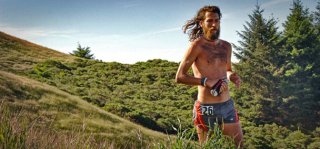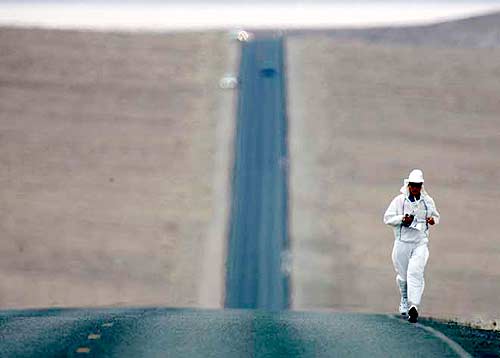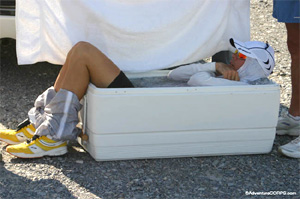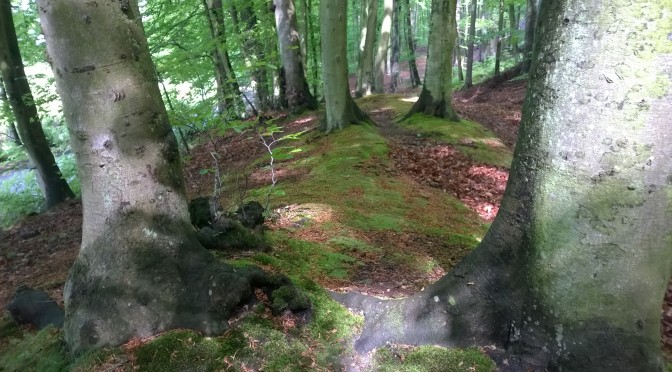Ultrasy to dość zróżnicowane środowisko gdzie spotkasz sportowców, byłych sportowców, artystów biegających na czuja, nie brakuje takich, którzy wloką ze sobą mocną historię z własnego życia, albo uciekających przez mrokiem alkoholu, dragów czy komputerów. Przybywają, by odnaleźć się w ciszy, przyrodzie, w przestrzeni gdzie jeszcze nie zawitał świat wielkiej komercji, popcornu i plastikowej codzienności. Szukają największych wyzwań i rywali, których darzy się najwyższym szacunkiem, wiedząc czego musieli dokonać, by stanąć na starcie. Przy piłkarzach to hipisi – jajcarze, jak Dean Karnazes, który w szczycie formy wyruszał dzień wcześniej biegiem na start maratonu oddalonego o 150km, odpoczywał godzinkę i pokonywał 42km w 3godziny 15minut.

Ultrasy zwykli być zgodni co do tego, że pierwszą część dystansu biegniesz nogami, drugą zaś głową. Bez motywacji, nie wyjdziesz na kolejne samotne treningi, nie przejdziesz przez pierwsze niepowodzenia, w końcu nie będziesz miał szans z kolejną falą bólu, która pojawi się na trasie wyścigu. Tak jak w pierwszych przypadkach pomoże muzyka, trener, kolega, tak w czasie próby trzeba sięgnąć znacznie głębiej. Wizualizacja sytuacji i osób, którym chcemy pomóc jest niezwykle skuteczna, zmienia proporcje i perspektywę widzenia naszego chwilowego problemu, poza tym nie chcesz właśnie ich zawieść – nawet jeśli się o tym nigdy nie dowiedzą, albo po prostu nie zdadzą sobie z tego sprawy. W sytuacji kryzysowej pomoże pamięć o bohaterach gór, biegunów polarnych i biegów ultra o ile będziesz w stanie coś pamiętać.
Czytając książkę Deana Karnazesa – ‘Ultramaratończyk’ znalazłem cytat, który autor umieścił w rozdziale poświęconym biegowi w Dolinie Śmierci – Badwater 217 km- który jest uznawany za jeden z najtrudniejszych biegów na świecie ze względu na niezwykle wysoką temperaturę (ok. 50stC) i przewyższenia. Zawodnicy starują z poziomu -86m poniżej poziomu morza a kończą powyżej Rysów (2500) – na Mount Whitney (2548mnpm).

Dean stracił przytomność i został zniesiony gdzieś w połowie trasy, co bardzo przeżywał, szczególnie dręczyło go to, że zawiódł tak wiele osób, które na niego liczyły, i które go wspierały. Długo mielił w sobie poczucie porażki, które darło jego sportowy honor i deptało poczucie wartości. Te chwile, jak później wspomina, były niezwykle potrzebne do zrobienia kolejnego kroku w karierze. Badwater pomogło Deanowi odczytać moment, w którym trzeba się cofnąć, by móc iść dalej. Kilka lat później wygrał ten bieg i to dwa razy (27g22min.), tuż po nim dwukrotnie królował Scott Jurek (24g26min.). Najlepszy w historii Brazylijczyk Valimir Nunes wykręcił 22g51min., a w śród kobiet Jamie Donaldson wygrywała z większością mężczyzn wyjątkowym czasem 26g16min. – uuff.

Zabieram ten cytat na Rzeźnika, a potem wsadzę do torby laptopa, przyda się na inne wyzwania – Wam też.
Theodore Roosvelt 1910 r. Francja źródło: http://www.theodore-roosevelt.com przekład Piotra Cieślaka z książki pt. Ultramaratończyk Dean Karnazes.
Chwała należy się temu, kto staje w szranki, a twarz jego splamiona jest pyłem, potem i krwią. Temu, kto odważnie stawia czoło; kto gubi się i popełnia błędy, choćby po wielokroć – nie ma bowiem przedsięwzięć bez błędów i błądzenia. Temu, kto stara się sprostać wyzwaniom, kto wie, czym jest wielka pasja i wielkie poświęcenie, kto oddaje się słusznej sprawie, kto w chwilach swych najlepszych triumfuje, zaś w najgorszych – nawet jeśli ponosi klęskę, to dając z siebie wszystko. Takim ludziom nigdy nie po drodze z nieczułymi, bojaźliwymi duszami, które nie zaznały ani smaku zwycięstwa, ani goryczy porażki.
Tomek
translation Anna Meysztowicz
Ultras (ultramarathon runners) are a pretty diversified circle where you can meet sportsmen, former sportsmen, artists feeling their way along. There is no shortage of those with tough life baggage, or those running away from the dark shadows of alcohol, drugs or computers. They come to discover themselves in silence, nature, in a space where the world of great commercialism, popcorn and plastic reality has not yet reached. They seek the greatest challenges and rivals who deserve the utmost respect knowing what they had to overcome to stand at the starting line. Next to soccer players they are hippies, jokers, like Dean Karnazes who, in peak form, set off a day earlier on foot to a marathon that was starting 150 km away. He rested an hour and covered the 42 km in 3 hrs and 15 minutes.
Ultras are all in agreement as to the fact that the first part of the distance you run with your legs, the rest with your head. Without motivation you will not get out to subsequent lonely training sessions, you will not experience your first failures, and finally you won’t stand a chance against the subsequent wave of pain that appears on the racing route. Just as during the first instances music, a trainer or friend can help, during the time of trial you have to reach much deeper. Visualising people and situations we want to help is incredibly effective, it changes the proportions and perspective of seeing our temporary problem, besides we don’t want to let them down – even if they won’t ever know about it, or are not able to understand. In a crisis situation it helps to think about the heroes of the mountains, the north and south poles, and ultramarathon runners, as long as you are capable of remembering anything at all.
Reading Dean Karnazes’ book – “Ultra-Marathon Man”, I found a quote that the author had included in the chapter dedicated to the run in Death Valley – Badwater 217 km – which is considered to be one of the most difficult runs in the world due to the incredibly high temperature (approx. 50°C) and elevations. Competitors start at -86 m below sea level and end higher than the Rysy Mountains (2,500 m) – on Mount Whitney (2548 m.n.p.m). Dean lost consciousness and was carried off somewhere halfway through the run, which he had a hard time accepting. He was especially worried about having let down so many people who had been counting on him and supported him. It took him a long time to digest the feeling of failure which tore at his sporting honour and stomped on his feelings of self-worth. Those moments, as he recalls later, were incredibly important in enabling him to take the following step in his career. Badwater helped Dean to reconise the moment when you have to take a step back in order to be able to move forward. A few years later he won that run – twice (27 h 22 min), after him Scott Jurek won twice as well (24 h 26 min). The best Brazilian in history, Valimir Nunes, conquered it in 22 h 51 min and, among the women, Jamie Donaldson won against a majority of male runners, with an exceptional time of 26 h 16 min – ufff.
I am taking this quote to the Rzeźnik run, and later I will put it into my laptop bag as it will be useful for other challenges too – for you as well.
“The credit belongs to the man who is actually in the arena, whose face is marred by dust and sweat and blood; who strives valiantly; who errs, who comes short again and again, because there is no effort without error and shortcoming; but who does actually strive to do the deeds; who knows great enthusiasms, the great devotions; who spends himself in a worthy cause; who at the best knows in the end the triumph of high achievement, and who at the worst, if he fails, at least fails while daring greatly, so that his place shall never be with those cold and timid souls who neither know victory nor defeat.”
Theodore Roosvelt – France, 1910. Source: http://www.theodore-roosevelt.com
Tomek
